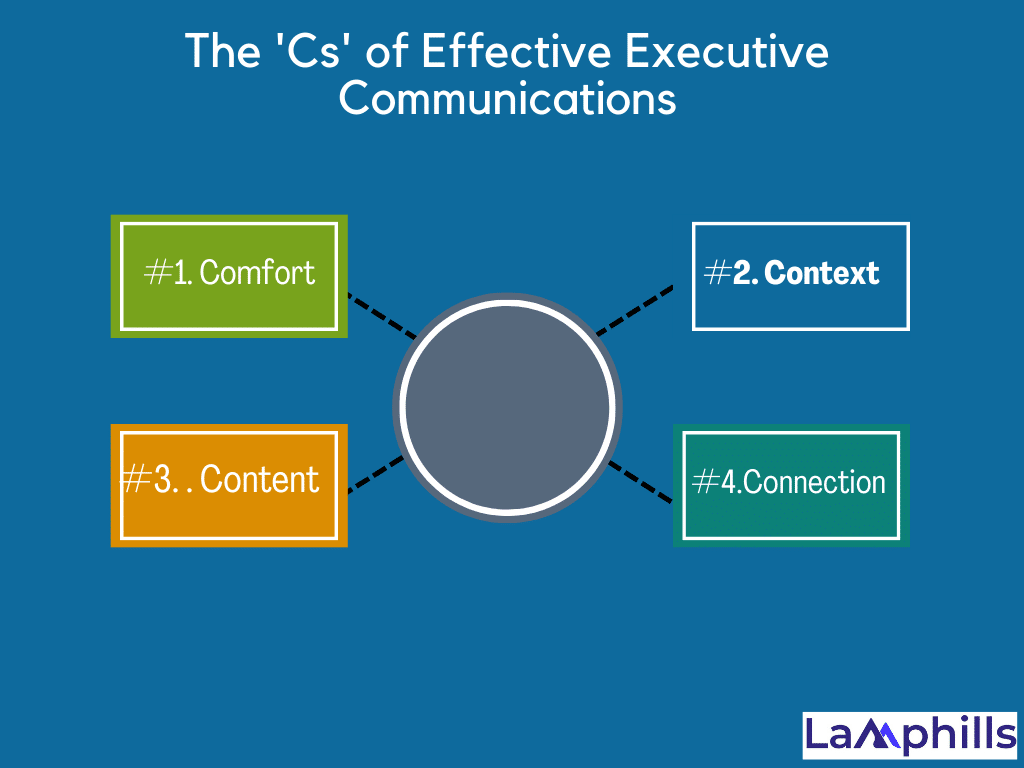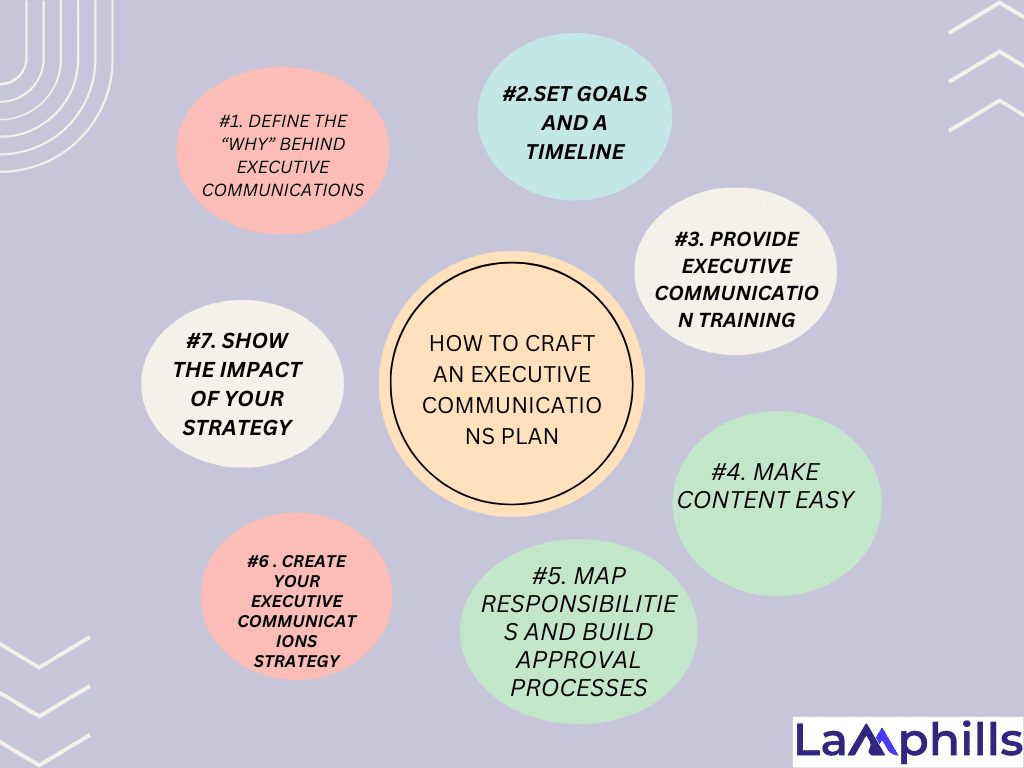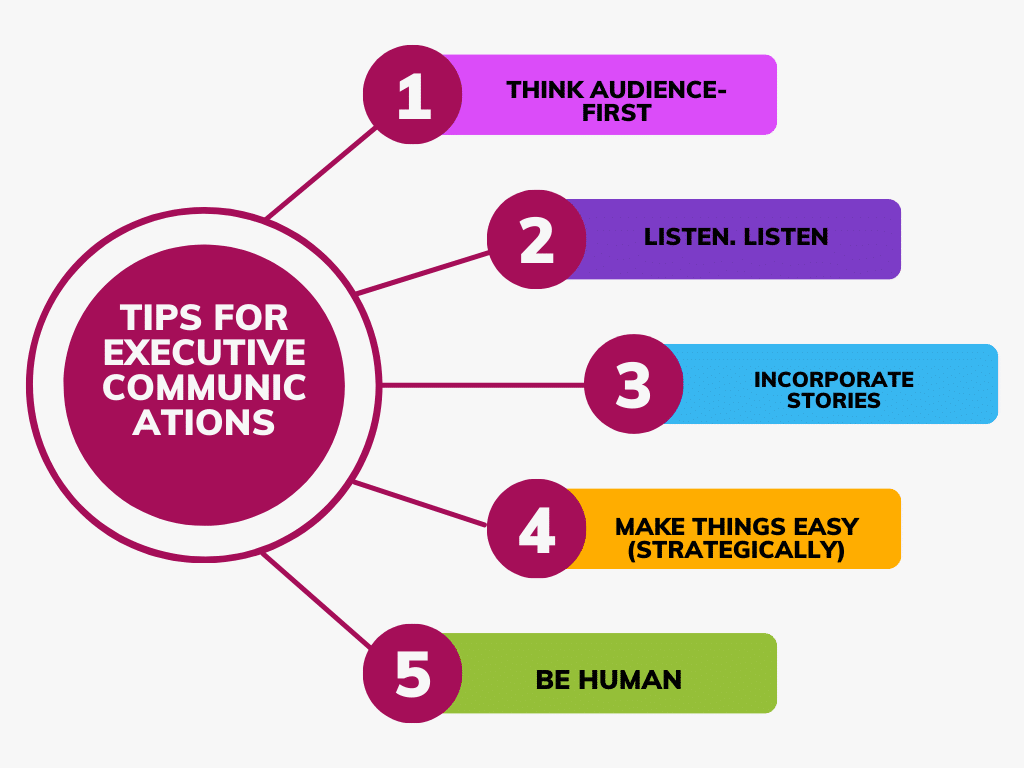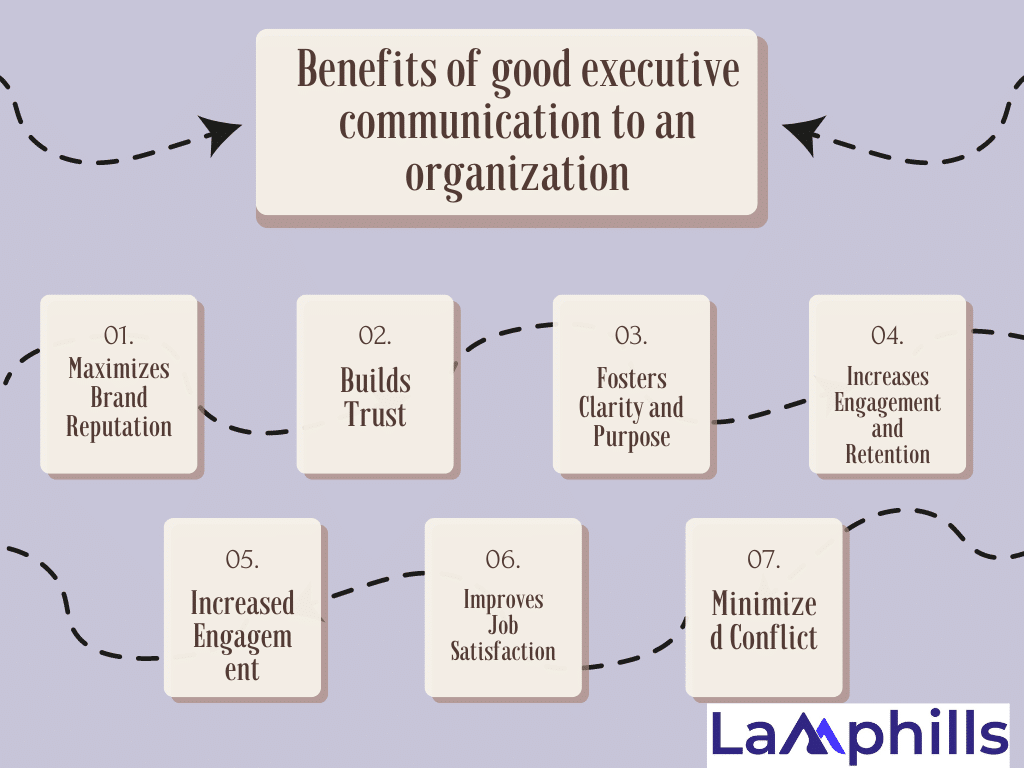In today’s business world, communications involve more than just words. That is, communication is vital in everything we do in business, including relationships with coworkers and team members. Trust me, I’ve personally seen the transformative effect of a well-crafted one. They do more than just inform; they inspire, motivate, and align teams around a single purpose. Whether meeting and training new staff, giving town halls or formal presentations for colleagues, or discussing ideas and project outcomes, effective executive communication skills can make the difference between a mediocre career and one where you climb the corporate ladder as high as your skill and determination can take you. So, what exactly is executive communications, and what can you expect to learn in this article? Read on, as I’ll break it down for you.
Key Takeaways
- Effective executive communication begins with leaders being at ease with their delivery. Whether speaking at a town hall or engaging in a media interview, the comfort level of the speaker significantly impacts their ability to connect with the audience and convey messages. Regular practice and training can help leaders overcome anxiety and improve their presentation skills.
- Tailoring messages to suit different audiences and contexts is crucial. This approach ensures that the message is relevant, engaging, and impactful for each specific audience.
- Successful executive communication requires a clear strategy, with defined goals and timelines. Whether aiming to boost engagement, enhance brand reputation, or drive strategic initiatives, having a well-thought-out communication plan helps leaders stay focused and aligned with organizational objectives.
- Authenticity in communication builds trust and fosters genuine connections. Leaders who openly share their challenges, values, and vision create a sense of shared purpose and loyalty among employees and stakeholders. This authenticity encourages open dialogue, strengthens organizational culture, and drives collective success.
What is Effective Executive Communication?

Executive communication is fundamentally a strategic dialogue between executives and their teams. This is more than just conveying information; it is also about fostering a common understanding and commitment. Imagine the town hall meetings hosted by the CEO of a technology business where I formerly worked.
These conversations were more than just updates; they allowed the CEO to connect with employees on a personal level, sharing not only corporate performance but also personal tales and insights. In the end, the strategy produced an open and trusting atmosphere, making each team member feel like an important part of the company’s progress.
When it comes to executive communications, it’s critical that signals are clear and staff understand their position. This is because, if there isn’t clarity, leaders may lose trust and credibility. Christiana Jolaoso, writing for Forbes Advisor, claims that workplace communication should go beyond information exchange. Hence, deliberate communication exercises must be included to promote confidence, foster participation, and increase overall company productivity.
Understanding Executive Communication
Executive communication is a type of internal communication in a corporation or organization. Simply described, it refers to communication between leaders and their staff. While the term originated with CEO communications, it may be used for any boss-employee dynamic. Executive communication has been practiced for generations. However, it is only in the digital age of mass communication that this profession has been acknowledged as deserving of its degree program.
Throughout most of the twentieth century, the boss’s business communication was limited to typed letters and memos, with a few slides and graphics generated for official onboarding sessions. With the advent of corporate computers, emails became the favored way of inter-office communication and casual engagement. Products similar to PowerPoint allow you to easily generate extensive and professional presentations for staff meetings without the need for a large support crew.
Texting has essentially overtaken email as the preferred method of informing employees about a new product, benefit, policy, or promotion. Choosing the proper media for the project has become more difficult, emphasizing the importance of good executive communication abilities.
Examples of Executive Communication
There’s no ‘one-size-fits-all’ when it comes to executive communication. In some cases, you’ll want to be more casual, while in others, you’ll want a written record of the exchange. Some examples of executive communication include:
- Emails
- Employee briefings or presentations
- Coffee talks with employees
- Written memos
- Town hall meetings
- Postings on private company social media groups
- Text messages
- Old-school phone calls
The ‘Cs’ of Effective Executive Communications

Great executive communications team members are more than just PowerPoint experts. To be truly effective in this capacity, you must be able to tell CEOs the hard realities, train them on sensitive themes, and understand how to translate dry corporate communications into something that sounds like actual phrases that real people would say and audiences would relate to. To ensure you’re placing your executive communications efforts in the appropriate place – and your executives in the best light, consider developing a program based on the four Cs of senior communications support:
#1. Comfort
Imagine preparing an experienced engineer for his first keynote address. Despite his technical expertise, the notion of public speaking was intimidating. We allayed his fears by providing him with extensive media training and mock interviews. We didn’t just teach him how to speak; we also helped him find his voice. This metamorphosis was obvious as he confidently delivered his first speech, engaging intimately with his audience. So, it is critical to create a comfortable setting in which CEOs may practice and perfect their performance. It’s not just about words; it’s about presence and authenticity.
#2. Context
Context is king. I remember a situation in which a corporation experienced a sudden PR crisis. The CEO, known for his technological expertise, needed to address the media and the public quickly. Understanding the sensitivity of the situation, we provided him with a thorough examination of the issue, potential questions, and the attitudes of the stakeholders concerned. His response was both knowledgeable and empathetic, transforming a potentially harmful occurrence into an example of transparent leadership. In these situations, aligning the executive’s brand with the company’s narrative is critical to preserving trust and credibility.
#3. Content
Effective communication is defined not only by what is said but also by how it is said. During an annual strategy review, one executive struggled to explain the complex figures he intended to present. We worked carefully together to reduce these details into engaging anecdotes and digestible insights that reflected his natural speaking style. This strategy ensured that the audience understood and embraced the content. Tailoring information to the executive’s voice and audience demands can transform dull data into intriguing narratives.
#4. Connection
Nowadays, people are talking about narrative as a crucial component of marketing everywhere. While the theme is somewhat excessively utilized, stories are a great way to convey a message, and they are even more effective when spoken by a genuine person with authenticity. Having good personal contact with CEOs can help in this situation. Understanding their background and personal life—where they grew up, the difficulties they faced, and their family situation—all of these factors can add to a personal narrative that can be used to highlight a commercial point.
How to Craft an Executive Communications Plan

Most executives are no strangers to leading strategy conversations, poring over financial projections, or weighing in on R&D. But elevating their communication strategy may not come as naturally. So, developing a clear plan that clearly illustrates your executives’ role, time commitment, goals, and return is the first step to securing buy-in. Here are some tips to help you craft a strategy:.
#1. Define the “Why” Behind Executive Communications
“Time is a limited resource for executives,” Hannah told Sprout. “So communications—especially external communications like thought leadership or speaking gigs—can be a tough sell. What’s important is to clearly articulate the ‘why’ behind it.” Not all executives will care about building a personal brand on Twitter. They will care about benefits to the business’s bottom line.
#2. Set Goals and a Timeline
Are you developing this plan to improve executive social media presence? Improve brand health? Build trust? Many of your goals will be related to your “whys.” If you need help identifying goals, go right to the source. Internally, consider conducting an anonymous survey of staff. What do they want to hear from the leadership? Do they prefer email or in-person coffee talks? What is their present perception?
Consider where you want to increase your leadership presence while developing external communications strategies. Setting goals for media placements or brand recognition is an excellent place to begin.
Finally, evaluate your leaders’ ambitions. As Hannah suggests, “Begin by having an open conversation with your leadership team about their communications goals—both personally and professionally.” Aligning your goals and guardrails from the start will save you time in the long run.
After you’ve determined your goals, create a realistic schedule for your strategy. Consider all of the elements required—how hands-on will your executives be? How often will content have to be developed and approved? Who else will be involved?
#3. Provide Executive Communication Training
How can you assist leaders in achieving success once they have bought in? Provide frequent training, ranging from corporate communications writing to media training for on-screen appearances. This can be as basic as hosting in-house thought leadership seminars to assist you and your executives in identifying and refining ideas and themes on which to talk.
These are not one-time events; instead, make training a consistent aspect of your plan. This will allow your leaders—and you—to communicate more truthfully. And this can help your efforts. In a recent webinar hosted by the National Retail Federation and Sprout, Walmart stated that training increased their executive audience reach by 182%.
Keep in mind that you can do everything correctly and still receive bad feedback. In addition to training, demonstrate your strategy’s safeguards—from social monitoring to media talking points. Set expectations, particularly when your CEOs take a strong public stance. Also, explain the system you have in place in case you experience blowback.
You can even underline how having this strategy in place will make it easier for your CEO to respond or speak in the event of a crisis.
#4. Make Content Easy
The easier the process of sharing content, the better. “Don’t just meet them in the middle of drafting or brainstorming, meet them at 80% and give them something to react to,” Hannah shares with Sprout. “Time is an executive’s most valuable resource, so if they’re investing it in communications, you need to maximize the ROI.”
To ensure buy-in, begin with some fast wins. As she advised, “Identify some easy ways for them to be more active, either on external channels like LinkedIn or Twitter or internally on Slack or email.” Using these to evaluate your approach while demonstrating ROI might help you and your executives feel more at ease.
Knowing your executives’ voices and interests is critical, whether you are ghostwriting or sourcing material for them. Consider establishing Twitter lists of industry executives and related news outlets for future reference. Also, keep an eye out for content opportunities everywhere. Hannah says, “Executives are extremely busy, so when their insights exist in a vacuum, you’ve missed an opportunity. We should always consider how we might use internal talk to create external content or convert a blog post into social content.” What existing content can you share? If you have an employee advocacy tool, this is a good place to start.
Pro tip: Try creating a content calendar to plan with your leaders. Identifying key dates for upcoming events, milestones, articles and more provides preparation time—even if that’s as simple as reminding them to snap a behind-the-scenes photo.
#5. Map Responsibilities and Build Approval Processes
Social media, video material, copy, and other forms of executive communication are all options. As a result, you will most likely need to incorporate stakeholders from different teams. Your procedure should be as simple and forward-thinking as feasible, especially if you’re using other employees’ time. Establishing particular approval processes establishes expectations for review time and preparation.
If executives wish to write their own material, an approval process allows you to alter messages and verify executives are accurately representing themselves and the business. If someone is ghostwriting, a transparent review process allows management to iterate and approve messaging to ensure authenticity. When it comes to social media posts, having a central center for drafts, edits, and reviews is beneficial. This procedure is made easier by Sprout’s integrated Social Media Calendar and Message Approval Workflows.
Set up systems to collect qualitative data. Capturing employee and shareholder feedback and sharing it with leadership can help them demonstrate the human aspect of their messaging. A social listening platform, such as Sprout, can assess sentiment and indicate how people perceive your executives’ channels, what they’re saying, and so on.
#6. Create an Effective Communications Strategy
You’re ready to use these tips to start crafting your executive communications strategy. Remember—nothing is set in stone. Leave room for adjustments where they’re needed.
Schedule time on your calendar to meet regularly with your executives to evaluate your strategy. What’s going well? What needs to change moving forward? This checklist below will also help you,
#7. Show the Impact of Your Strategy
Deep inhale, deep exhale. You’ve devised a clear approach. Now, continue to demonstrate the impact of your efforts by reporting on returns. data does not lie. Regularly convey quantitative findings to your leaders in a narrative format.
What is an executive communication plan?
An executive communication plan outlines a strategy for communicating with key stakeholders, such as consumers, staff, and business partners. It should include a thorough explanation of the message to be sent, who will receive it, and when it will be sent.
The plan should also outline how communication will be tracked and reviewed to determine its success. Finally, the plan should specify when each phase of the process will be completed.
Tips for Executive Communications

Utilize these tips to create effective executive communications
#1. Think Audience-First
My golden rule is: that it’s not about what you want to say, it’s about what the audience needs to hear. For example, you wouldn’t use the same talking points during a board address as you would in an all-staff meeting. The board may be looking for detailed financial updates and long-term growth projections. However, employees may want to know how the numbers will impact their bonuses and day-to-day operational initiatives. So, executives need to approach every engagement through an audience-centric lens.
#2. Listen. Listen and Listen
It is easy to forget that listening is a necessary part of communication, which is a two-way street. After all, if you don’t actively listen to stakeholders, you won’t know what they need or want to hear. This means you can send out surveys, run focus groups, open a suggestion box, or have one-on-one discussions to gain a sense of how stakeholders feel. You can’t, however, end there. You have to be very conscious of that input when you are creating messages. While Adaptive ListeningTM can help you go even farther, active listening is a fantastic place to start.
#3. Incorporate Stories
Almost every choice made by executives is based on data. However, it is in everyone’s best interest to avoid the dreaded “data dump” while speaking with stakeholders. Audiences are not captivated by facts and data on their own. However, stories have been shown by science to be able to draw in and hold the attention of an audience. Executives and communicators of all stripes can maximize their message and inspire audiences by learning from Duarte how to tell stories with data.
#4. Make Things Easy (strategically)
Nobody likes to leave a meeting feeling more confused than resolved. Thus, it’s imperative to design a message that is clear and concise. Steer clear of employing technical phrases and jargon that your audience might not comprehend. Content should be customized for the audience you are speaking to. (see tip #1). So, focus only on what your audience needs to hear, and leave any irrelevant, overly technical details out.
#5. Be Human
Executives are sometimes treated as though they are superior to those who are not C-suiters. However, like the rest of us, executives are also people. They have homes, interests, aspirations, and worries. Humanity is also in. Customers and staff alike are looking for authenticity. creates transparency and a new window of perfection, but a new window opens.
Authentic leaders help their firms retain more customers, attract new clients, and hire more staff. brings up a new window Therefore, when speaking in public, executives shouldn’t be scared to be authentic, share their tales (oops, see advice #3), and own up to their mistakes.
Benefits of Good Executive Communication to an Organization

A competent company leader will be able to reduce conflict while maximizing productivity, employee engagement, motivation, and work happiness. These are all significant potential economic advantages of improved CEO communications and contemporary leadership. You can probably envision the opposite of what I’ve just described, But first, let me clarify why having great communication has such wide-ranging effects on your company.
#1. Maximizes Brand Reputation
A strong executive voice is one of the most impactful ways to represent a brand. Executives have the platform needed to:
- Spearhead change
- Demonstrate company values
- Regulators
- Customers
Shine a light on organizational culture—if they can communicate successfully, that is when executives communicate clearly and charismatically, they instill trust in their organization’s future, attracting support from both investors and customers.
Furthermore, Sprout Social discovered that 32% of consumers who opened a new window said CEO transparency on social media would encourage them to buy from that company.
#2. Builds Trust
Executives who communicate consistently and transparently build trust with their staff. When leaders keep employees informed about important decisions and changes, employees are more likely to feel valued, respected, and safe. We operate at a time when employees may experience a sense of ‘separateness’ as they work from home. Not to mention that they may feel less secure in their position as economic uncertainty prevails. So building trust as a leader is a must.
#3. Fosters Clarity and Purpose
When leaders communicate their vision, priorities, and progress clearly and authentically, employees understand what’s expected of them and can see how their work contributes to their company’s overall success. This promotes a sense of purpose, making employees feel part of something bigger than themselves.
#4. Increases Retention
Effective communication by CEOs generates trust, clarity, and a sense of purpose, resulting in satisfied and loyal employees. Just as poor executive communication causes a domino effect, so does effective executive communication.
According to one survey (opens a new window), 84% of employees with good role clarity expect to stay with their company. Another study opens a new window, revealing that “trust in leaders” is the leading predictor of employee engagement. Good executive communication can determine your organization’s success or failure.
#5. Increased Engagement
Effective executive communications offer various advantages, including greater workplace engagement. These include improving relationships between management and employees and increasing employee engagement. When management respects employees’ needs and communicates effectively, it is simpler to harness their abilities and talents for common goals.
#6. Improves Job Satisfaction
In another Forbes Advisor post, Leeron Hoory discussed their research into workplace communication and productivity. The survey she reported on included hybrid (53%), remote (27%), and on-site staff (20%). It discusses several topics, but one that sticks out is the impact on job satisfaction. Nearly half (48%) of those polled felt that a lack of effective communication impacted their job satisfaction.
#7. Minimized Conflict
Workplaces inherently consist of individuals from diverse cultures and belief systems, making conflicts inevitable. Yet, a significant portion of these conflicts tend to arise from ineffective communication methods. Work environments that prioritize open internal communication styles can expect a decrease in conflicts, both between managers and employees and among employees. These potential benefits all become possible when those in authority hone their executive leadership skills and maximize the value of communication.
What is the function of executive communications?
Executive communications play a pivotal role in a company’s internal communication plan. They provide leadership with a platform to articulate organizational goals, foster transparency, and align employees with the company’s vision.
What is the difference between executive communications and internal communications?
Any two people within the company can communicate internally. However, executive communications means that at least one member of the company’s executive team is involved.
Is internal communications part of HR or marketing?
The main difference is that internal communications is focused on creating and sharing organizational messages, while HR is focused on managing employee relationships.
Conclusion
In today’s fast-paced corporate climate, executive communication is more than a skill; it is a strategic asset. It bridges the gap between leadership and teams, bringing everyone together around common goals and cultivating a culture of trust and engagement. As you develop your communication tactics, keep in mind that it’s about more than just delivering words; it’s about engaging with people and motivating those who follow you. Now, by following these executive communication planning strategies here, you can ensure that your communications are clear and effective and that they are heard by the people who need to hear them
References
- online.jwu.edu
- idealsboard.com
- sproutsocial.com
- cerkl.com






